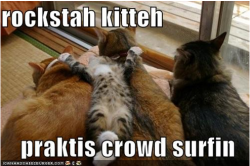Slang

Introduction
Due to technological advances and constant access to the media, an unprecedented amount of information floods the public consciousness with an unprecedented immediacy. The Internet in particular has accelerated the rate of growth and the spread of pop culture, news, media, and other forms of texts. This rapid circulation of ideas facilitates and accelerates the creation of new language and the spread of language trends. Students either create new words or appropriate language from popular culture for informal daily use, contributing to the ever-changing language in the form of slang. In this way, they contribute to slang, defined for the purposes of this project as new and informal language. Students also face new and unfamiliar language, whether in informal or more sophisticated texts. Media affects the growth and prevalence of slang either by introducing it, or pulling it into common usage.
With the influx of ideas, agendas, slang, and academic vocabulary pervading the public consciousness, and in order to discern true and relevant information out of the white noise, students must learn how to comprehend texts, engage in the language, and critically analyze the presented message. Unfamiliar language can serve as a barrier to understanding, and the constant proliferation of this language makes it difficult for students to keep up with the changes media sources and popular culture announce. Besides the meaning of a word itself, nuances, connotations, and cultural concepts associated with well-known words also hinder understanding, especially for those students unfamiliar with mainstream American culture. Nuances of language, and diction itself, powerfully affect one’s immediate meaning and overall message. Therefore, it is crucial that students learn to decode unfamiliar texts, as well as to command language for themselves in such a way as to express clearly and precisely what they mean. This leads to clear communication, which is necessary to connect to others and build community.
As new words from popular culture media are absorbed into mainstream discourse, to what extent is the divide between slang and standard (or academic) English narrowed? How does media language affect the texts that the American public consume, especially given the immediacy of publication that technology makes possible? Why should slang get more respect? I will investigate the answer to this question in the following ways: a look at the creation of slang, its relation to youth culture, the incorporation of slang into standard English, and its application to the classroom.
Due to technological advances and constant access to the media, an unprecedented amount of information floods the public consciousness with an unprecedented immediacy. The Internet in particular has accelerated the rate of growth and the spread of pop culture, news, media, and other forms of texts. This rapid circulation of ideas facilitates and accelerates the creation of new language and the spread of language trends. Students either create new words or appropriate language from popular culture for informal daily use, contributing to the ever-changing language in the form of slang. In this way, they contribute to slang, defined for the purposes of this project as new and informal language. Students also face new and unfamiliar language, whether in informal or more sophisticated texts. Media affects the growth and prevalence of slang either by introducing it, or pulling it into common usage.
With the influx of ideas, agendas, slang, and academic vocabulary pervading the public consciousness, and in order to discern true and relevant information out of the white noise, students must learn how to comprehend texts, engage in the language, and critically analyze the presented message. Unfamiliar language can serve as a barrier to understanding, and the constant proliferation of this language makes it difficult for students to keep up with the changes media sources and popular culture announce. Besides the meaning of a word itself, nuances, connotations, and cultural concepts associated with well-known words also hinder understanding, especially for those students unfamiliar with mainstream American culture. Nuances of language, and diction itself, powerfully affect one’s immediate meaning and overall message. Therefore, it is crucial that students learn to decode unfamiliar texts, as well as to command language for themselves in such a way as to express clearly and precisely what they mean. This leads to clear communication, which is necessary to connect to others and build community.
As new words from popular culture media are absorbed into mainstream discourse, to what extent is the divide between slang and standard (or academic) English narrowed? How does media language affect the texts that the American public consume, especially given the immediacy of publication that technology makes possible? Why should slang get more respect? I will investigate the answer to this question in the following ways: a look at the creation of slang, its relation to youth culture, the incorporation of slang into standard English, and its application to the classroom.
